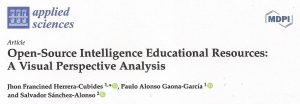What is this paper all about?
And in relation to your first answer, isnt't this data too critical to be shared with the public?
PDF (25 Pages): Academic Open Source Educational Resources
Dear Colleague,
20% of this paper is useful. As you yourself pointed out to me, this opened up your mind by directing your thoughts toward reviewing the potential OSINT sources in South Asia and China. while you were also searching for some map which will depict the number of newspapers or journals etc in South Asia and China.
These people have no idea how wrong they are in mis-appropriating the term OSINT for what is a bastardization that combines weak academic practices with shallow online sources.
They are recycling stuff I pioneered and others stole without understanding that their charts are largely worthless by being out of context from the larger body of knowledge most of which is not online and much of which is not published at all — i.e. original HUMINT that must be elicited one mind at a time.
On balance this is another drunk (three drunks) under the streetlamp looking for car keys that are far far away from where they are. They are not using the term OSINT correcting. Any article that does not mention my work or the term “citation analytics” is stupid by definition. These people have good intentions but they are playing in the mud of what is free online and also completely obivious to the fact that we are losing the equivalent of a Library of Alexandria every day as peer reviewed journals go offline, YouTube wipes out entire bodies of work, etcetera.
I found some of their links interesting but the reality is that only a subject matter expert combined with a trained information broker who is also a subject matter expert combined with a primary researcher who can tap into humans via telephone, email, video conference or in person, can get to the core knowledge.
Everything this paper is talking about is both superficial and suspect.
Below cost me $30,000. Sadly DIALOG has been pressured to delete the RANK functionality that allowed the top experts to be identified for roughly $1000 per search (e.g. poverty), I suspect the Institute of Scientific Information (ISI) or Dick Klavens would charge at least $5000 per topic, not unreasonable for the value provided.
2007 Earth Intelligence Network — Authors, Books, Centers, Forecasts
2007 is a long way back.
If I had an open source agency with a multinational decision-support centre, these would not just be kept updated at the global level in each of the main languages, but at the national and provincial or state levels.
Also the published experts are a back door to the unpublished experts consisting of graduate students doing new work not published, and field or indigenous experts who are “doing” instead of writing.
You reacted to the above with concern about sharing information.
Alvin Toffler (RIP) was my friend and honored me with a chapter built around me “The Future of the Spy” in War and Anti-War. In his book PowerShift he made the point that information is the only “good” that can be shared and still be retained by the original owner or creator.
In about 1994 I was in a Hackers meeting in California with Eric Hughes and John McCarthy (father of AI) among others and we talked about the value of sharing information. Our conclusion was that shared information is a MAGNET.
For every piece of information that I share I get back roughly 100 pieces of unsolicited information I would not otherwise have seen, 10 of which are useful to me.
That is both a 10-1 noise ratio in the return, and 10-1 value ratio in the end.
OSINT acquires value by being shared. The only exception is Black OSINT.
This is why an Open Source Agency must have a Multinational Decision-Support Centre with reachback to all militaries in the world, who in turn organize access to and sharing with their “eight tribes” of information at the national and province or state levels.
Data is not the new gold. Data is shit. DECISION-SUPPORT rooted in holistic analytics and true cost economics, in turn founded upon access to all information in all languages all the time, is the new gold.
SEE ALL
Note: Short URL for the entire series including new posts is
https://tinyurl.com/OSINT-India
See Also:





